Lancia Thesis 2007 Owner handbook (in English)
Manufacturer: LANCIA, Model Year: 2007, Model line: Thesis, Model: Lancia Thesis 2007Pages: 386, PDF Size: 8.69 MB
Page 331 of 386

330
SPARK PLUGS
The cleanness and soundness of the
spark plugs are very important for
keeping the engine efficient and pol-
luting emissions down.
The appearance of the spark plug,
if examined by expert eyes, is a good
way of pinpointing a problem even if
it has nothing to do with the ignition
system. Therefore, if the engine has
problems, it is important to have the
spark plugs checked at a Lancia
Dealership.
The spark plugs must be
changed at the times
specified in the Service
Schedule. Only use the type of
plugs indicated. If the heat ratio
is less than required or the life
specified is not guaranteed, prob-
lems can arise.
ELECTRONIC
CONTROL UNITS
When the car is being used normal-
ly, special measures are not neces-
sary.
The following instructions must be
followed very carefully, however, if
you work on the electrical system or
in cases where emergency starting is
necessary:
– never disconnect the battery from
the electrical system while the
engine is running
– disconnect the battery from the
electrical system if you are recharg-
ing it. The modern battery chargers
can discharge voltage up to 20V
– never perform emergency start-
ups with a battery charger. Always
use an auxiliary battery
– be particularly careful when con-
necting the battery to the electrical
system. Make sure that the polarity
is correct and that the connection is
efficient– do not connect or disconnect the
terminals of the electronic control
unit while the ignition key is at MAR
– do not check polarity through
sparking
– disconnect the electronic control
units if you are electrically welding
the car body. Remove the units if
temperatures exceed 80°C (special
operations on the bodywork, etc.).
Modifications or repairs
to the electrical system
carried out incorrectly
and without bearing the features
of the system in mind can cause
malfunctions with the risk of fire.
Page 332 of 386
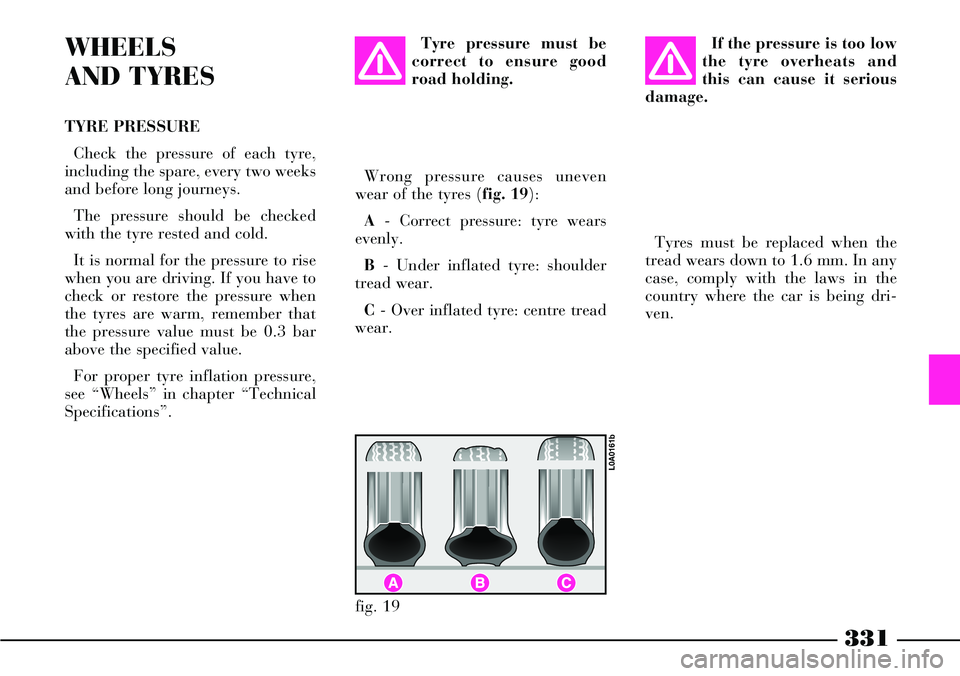
331
WHEELS
AND TYRES
TYRE PRESSURE
Check the pressure of each tyre,
including the spare, every two weeks
and before long journeys.
The pressure should be checked
with the tyre rested and cold.
It is normal for the pressure to rise
when you are driving. If you have to
check or restore the pressure when
the tyres are warm, remember that
the pressure value must be 0.3 bar
above the specified value.
For proper tyre inflation pressure,
see “Wheels” in chapter “Technical
Specifications”.Tyre pressure must be
correct to ensure good
road holding.
Wrong pressure causes uneven
wear of the tyres (fig. 19):
A- Correct pressure: tyre wears
evenly.
B- Under inflated tyre: shoulder
tread wear.
C- Over inflated tyre: centre tread
wear.If the pressure is too low
the tyre overheats and
this can cause it serious
damage.
Tyres must be replaced when the
tread wears down to 1.6 mm. In any
case, comply with the laws in the
country where the car is being dri-
ven.
fig. 19
L0A0161b
Page 333 of 386
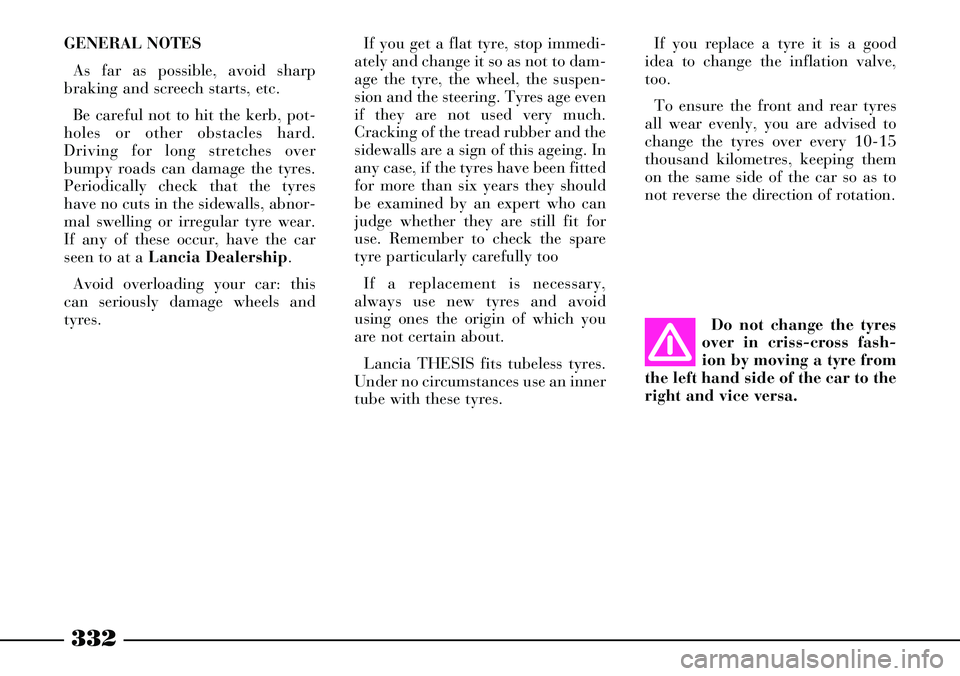
332
If you replace a tyre it is a good
idea to change the inflation valve,
too.
To ensure the front and rear tyres
all wear evenly, you are advised to
change the tyres over every 10-15
thousand kilometres, keeping them
on the same side of the car so as to
not reverse the direction of rotation.
Do not change the tyres
over in criss-cross fash-
ion by moving a tyre from
the left hand side of the car to the
right and vice versa.GENERAL NOTES
As far as possible, avoid sharp
braking and screech starts, etc.
Be careful not to hit the kerb, pot-
holes or other obstacles hard.
Driving for long stretches over
bumpy roads can damage the tyres.
Periodically check that the tyres
have no cuts in the sidewalls, abnor-
mal swelling or irregular tyre wear.
If any of these occur, have the car
seen to at a Lancia Dealership.
Avoid overloading your car: this
can seriously damage wheels and
tyres.If you get a flat tyre, stop immedi-
ately and change it so as not to dam-
age the tyre, the wheel, the suspen-
sion and the steering. Tyres age even
if they are not used very much.
Cracking of the tread rubber and the
sidewalls are a sign of this ageing. In
any case, if the tyres have been fitted
for more than six years they should
be examined by an expert who can
judge whether they are still fit for
use. Remember to check the spare
tyre particularly carefully too
If a replacement is necessary,
always use new tyres and avoid
using ones the origin of which you
are not certain about.
Lancia THESIS fits tubeless tyres.
Under no circumstances use an inner
tube with these tyres.
Page 334 of 386
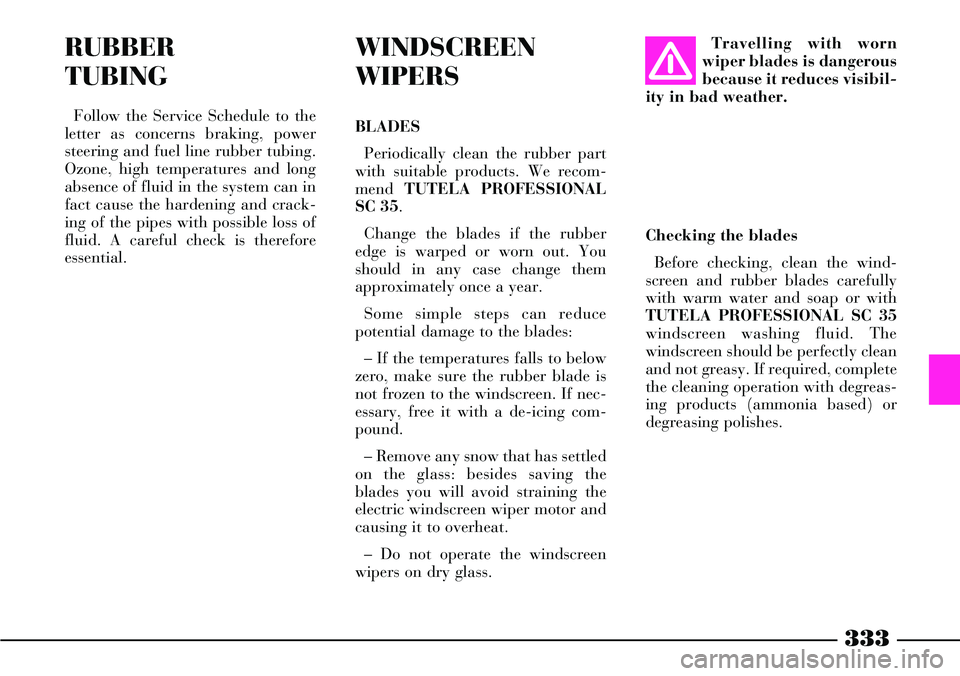
333
RUBBER
TUBING
Follow the Service Schedule to the
letter as concerns braking, power
steering and fuel line rubber tubing.
Ozone, high temperatures and long
absence of fluid in the system can in
fact cause the hardening and crack-
ing of the pipes with possible loss of
fluid. A careful check is therefore
essential.
WINDSCREEN
WIPERS
BLADES
Periodically clean the rubber part
with suitable products. We recom-
mendTUTELA PROFESSIONAL
SC 35.
Change the blades if the rubber
edge is warped or worn out. You
should in any case change them
approximately once a year.
Some simple steps can reduce
potential damage to the blades:
– If the temperatures falls to below
zero, make sure the rubber blade is
not frozen to the windscreen. If nec-
essary, free it with a de-icing com-
pound.
– Remove any snow that has settled
on the glass: besides saving the
blades you will avoid straining the
electric windscreen wiper motor and
causing it to overheat.
– Do not operate the windscreen
wipers on dry glass.Travelling with worn
wiper blades is dangerous
because it reduces visibil-
ity in bad weather.
Checking the blades
Before checking, clean the wind-
screen and rubber blades carefully
with warm water and soap or with
TUTELA PROFESSIONAL SC 35
windscreen washing fluid. The
windscreen should be perfectly clean
and not greasy. If required, complete
the cleaning operation with degreas-
ing products (ammonia based) or
degreasing polishes.
Page 335 of 386
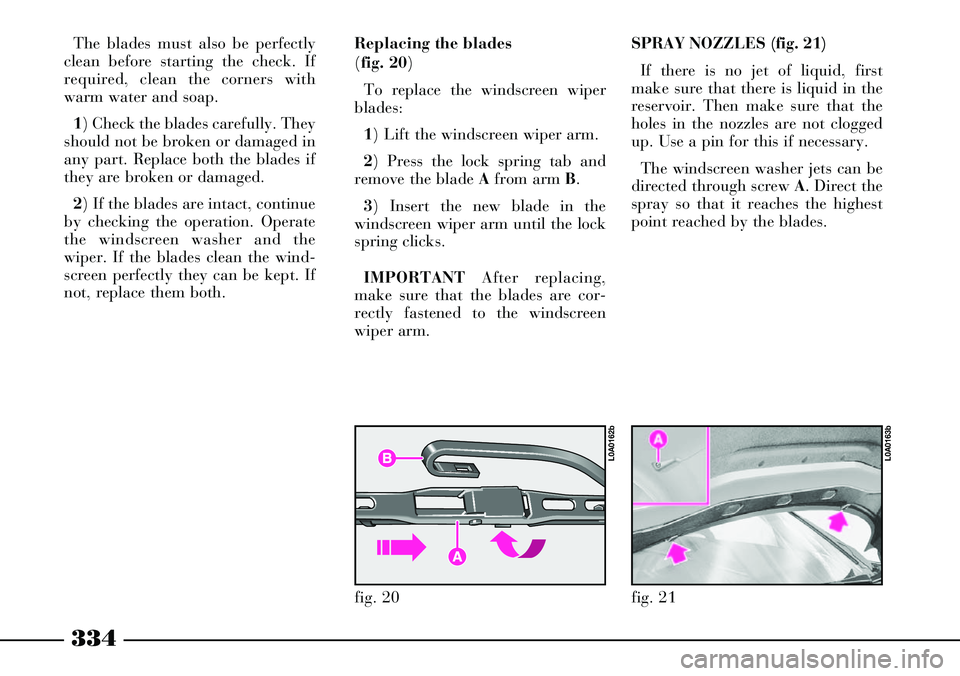
334
SPRAY NOZZLES (fig. 21)
If there is no jet of liquid, first
make sure that there is liquid in the
reservoir. Then make sure that the
holes in the nozzles are not clogged
up. Use a pin for this if necessary.
The windscreen washer jets can be
directed through screw A. Direct the
spray so that it reaches the highest
point reached by the blades.
fig. 21
L0A0163b
The blades must also be perfectly
clean before starting the check. If
required, clean the corners with
warm water and soap.
1) Check the blades carefully. They
should not be broken or damaged in
any part. Replace both the blades if
they are broken or damaged.
2) If the blades are intact, continue
by checking the operation. Operate
the windscreen washer and the
wiper. If the blades clean the wind-
screen perfectly they can be kept. If
not, replace them both.Replacing the blades
(fig. 20)
To replace the windscreen wiper
blades:
1) Lift the windscreen wiper arm.
2) Press the lock spring tab and
remove the blade Afrom arm B.
3) Insert the new blade in the
windscreen wiper arm until the lock
spring clicks.
IMPORTANTAfter replacing,
make sure that the blades are cor-
rectly fastened to the windscreen
wiper arm.
fig. 20
L0A0162b
Page 336 of 386

335
HEADLIGHT
WASHERS
Regularly check that the nozzles
(fig. 22) are intact and clean.
The headlight washers are auto-
matically switched on when the
windscreen washer is operated and
the headlights are on.
CLIMATE
CONTROL SYSTEM
During the winter, the climate con-
trol system must be turned on at
least once a month for about ten
minutes.
Before summer, have the system
checked at a Lancia Dealership.INITIALISING THE AIR
CONDITIONING CONTROL UNIT
Whenever the battery is electrically
connected again or it is reloaded after
being completely flat or after replac-
ing one of the protection fuses, to re-
store the correct operation of the air
conditioning, of the door locking and
of the ESP system. It is necessary to
perform the initialisation operations
contained in the paragraph “If battery
is to be disconnected” in the chapter
“In an emergency”.
fig. 22
L0A0122b
The system is filled with
R134a refrigerant which
will not pollute the envi-
ronment in the event of leakage.
Under no circumstances should
R12 fluid be used as it is incom-
patible with the system compo-
nents and contains CFC.
Page 337 of 386

336
BODYWORK
PROTECTING THE CAR FROM
ATMOSPHERIC AGENTS
The main causes of rust are:
– atmospheric pollution
– salty and humidity in the atmos-
phere (coastal or very hot and
humid areas)
– environmental conditions that
specific to the season.
In addition, the abrasiveness of
dust in the atmosphere and sand
carried by the wind as well as mud
and stones kicked up by other cars
must not be underestimated.
For your THESIS, LANCIA has
used leading-edge technological
solutions to effectively protect the
body from rust.These are most important:
– Painting systems and products
that make the car particularly resis-
tant to rust and scratching.
– The use of zinc-plated sheet steel
which is highly resistant to rust.
– The spraying of the underbody,
engine compartment, inside the
wheelhouses and other parts with
wax-based products with a high pro-
tective capacity.
– Spraying plastic-coating materi-
als, to protect the most exposed
points: under the door, inside the
wings, the edges, etc.– The use of “open” box sections to
prevent condensation and water
from building up and rusting the
inside of the parts.
BODY AND UNDERBODY
WARRANTY
Your THESIS is covered by war-
ranty against any original structural
or body part being perforated by
rust. Refer to the Warranty Booklet
for the general terms.
Page 338 of 386
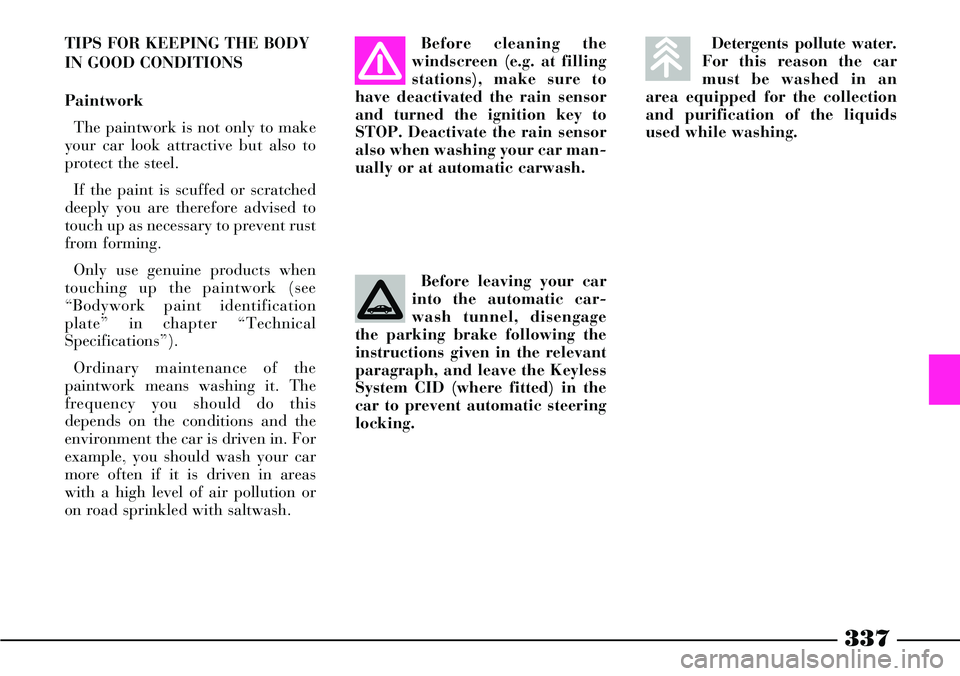
337
Detergents pollute water.
For this reason the car
must be washed in an
area equipped for the collection
and purification of the liquids
used while washing.TIPS FOR KEEPING THE BODY
IN GOOD CONDITIONS
Paintwork
The paintwork is not only to make
your car look attractive but also to
protect the steel.
If the paint is scuffed or scratched
deeply you are therefore advised to
touch up as necessary to prevent rust
from forming.
Only use genuine products when
touching up the paintwork (see
“Bodywork paint identification
plate” in chapter “Technical
Specifications”).
Ordinary maintenance of the
paintwork means washing it. The
frequency you should do this
depends on the conditions and the
environment the car is driven in. For
example, you should wash your car
more often if it is driven in areas
with a high level of air pollution or
on road sprinkled with saltwash.Before leaving your car
into the automatic car-
wash tunnel, disengage
the parking brake following the
instructions given in the relevant
paragraph, and leave the Keyless
System CID (where fitted) in the
car to prevent automatic steering
locking.Before cleaning the
windscreen (e.g. at filling
stations), make sure to
have deactivated the rain sensor
and turned the ignition key to
STOP. Deactivate the rain sensor
also when washing your car man-
ually or at automatic carwash.
Page 339 of 386

338
Outside plastic parts must be
cleaned following the usual car
washing procedure.
Where possible avoid parking the
car under trees; the resinous sub-
stance that certain species of tree
shed dull the paintwork and increase
the possibility of rust forming.
IMPORTANTBird droppings
must be washed off immediately and
with great care as their acid is par-
ticularly aggressive.
Windows
Use specific window cleaners to
clean the windows. Use very clean
cloths to avoid scratching the glass
or damaging the transparency.
IMPORTANTTo prevent damage
to the electric heater element, wipe
the inside of the heated rear window
gently in the same direction as the
elements. To wash the car properly:
1) Remove the aerial from the roof
to prevent damaging it when wash-
ing the car in an automatic carwash.
2) Wash the body using a low pres-
sure jet of water.
3) Wipe a sponge with a light neu-
tral PH detergent solution over the
bodywork, frequently rinsing the
sponge.
4) Rinse well with water and dry
with a jet of air or a chamois leather.
When drying the car, be careful to
get at those parts which are not so
easily seen e.g. the door frames, bon-
net and around the headlights where
water can most readily collect.
You should leave the car out in the
open so that any water remaining
can evaporate more easily.
Do not wash the car after it has
been parked in the sun or while the
bonnet is hot: it could take the shine
off the paint. Cleaning chromium
plated/anodized bodywork parts
To clean body parts such as mold-
ings, cappings, etc., use neutral pH
detergents. Avoid generic cleaning
products.
These parts shall be rinsed well with
water and then dried with a jet of air
or a chamois leather.
For further treatment use special
polish for chromium plated/anodized
parts.
Suitable car cleaning products are
available at Lancia Dealerships.
Page 340 of 386

339
Engine compartment
At the end of each winter season,
carefully clean the engine compart-
ment without directing the water jet
against electronic control units.
Have this done at a garage.
Detergents pollute water.
For this reason the car
must be washed in an
area equipped for the collection
and purification of the liquids
used while washing.
IMPORTANTThe car should
washed with the engine cold and the
ignition key at STOP. After washing
make sure that the various protec-
tions (e.g. rubber caps and various
covers) have not been damaged or
removed.INTERIORS
From time to time check that water
has not collected under the mats
(from dripping shoes, umbrellas,
etc.) which could cause the steel to
rust.
Never use inflammable
products like fuel oil
ether or rectified petrol
for cleaning inside the car. The
electrostatic discharges generat-
ed when rubbing to clean may
cause fire.
Do not keep aerosol cans
in the car. There is the
risk they might explode.
Aerosol cans must never be
exposed to a temperature above
50°C; when the weather starts to
get hot the temperature inside the
car might go well beyond that fig-
ure.
PLASTIC PARTS INSIDE
THE CAR
Use special products designed not
to alter the appearance of the com-
ponents.
IMPORTANTDo not use alcohol
or petrol to clean the instrument
panel.
CLEANING ALCANTARA
SEATS
Alcantara upholstery is easy to
clean. Follow the same instructions
provided for velvet upholstery.